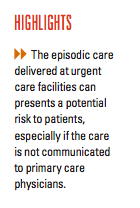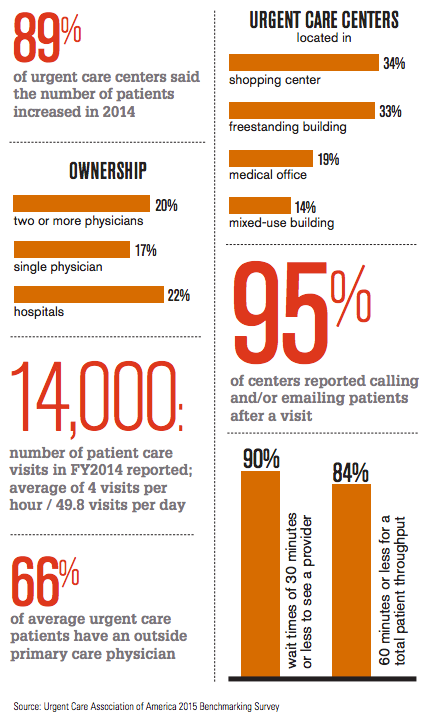Article
How urgent care relates to physicians practices
Author(s):
An in-depth look into how these new care collaborators can complement, not compete, with your services.

Primary care physicians have long viewed urgent care centers as a threat, a costly convenience, and a barrier to continuity of care. And at one time all of that may have been true.
But as the outpatient medicine market evolves, the benefits of having a new link in the care continuum chain have also become clear. Urgent care centers not only improve access, but liberate primary care providers to do what they do best: preventive medicine and chronic care management, says David Meyers, MD chief medical officer for the Agency for Healthcare Research and Quality.
Top 8 insights into the financial state of primary care
âIs this the end of primary care? No way,â says Meyers, a family physician. âAt its best, primary care [practices are] focused on prevention and wellness, on the ongoing treatment of chronic disease, depression, and end-of-life care. Thatâs the foundation of our healthcare system. Thatâs what primary care is.â
Urgent care centers donât compete with physician practices, he contends, they complement them. Payment reform, telehealth technology and a growing emphasis on patient-centered medicine have redefined how care is delivered, Meyers says. âWe are living in a very exciting time of significant healthcare change,â he says. âUrgent care centers help put resources in the right places.â

The move to âbest fitâ medicine, in which patients receive the right level of care where and when they want it, comes not a moment too soon. As the population ages, a growing percentage of patients require the expertise of a primary care physician to treat complex medical conditions, says Meyers.
Because many medical practices struggle to keep pace with demand, however, patients who require disease management expertise often must wait weeks or months to be seen by their primary care doctor, a dangerous by product of the primary care physician shortage.
The Association of American Medical Colleges projects a shortfall of up to 31,100 primary care physicians by 2025. At present, roughly 50 million Americans live in areas--most of which are rural--with an undersupply of primary care physicians, according to the Health Resources and Services Administration.
Wait times at primary care physician practices are likely to worsen before they get better. Millions more Americans are now insured under the Affordable Care Act, which could generate an additional 25 million primary care visits annually, according to projections from the Centers for Medicare and Medicaid Services. âThatâs putting an added strain on the healthcare system and the place weâre seeing that strain most is in acute care,â says Meyers, adding that urgent care centers can help alleviate some of that strain.
Next: Cost-effective care
Cost-effective care
Urgent care clinics evaluate and treat medical problems at the lower end of the severity spectrum, such as asthma attacks, stitches, infections, and broken toes.
The business model was born in the 1990s in response to the need for quick and convenient care of non-emergency medical conditions when doctorâs offices were closed, says Franz Ritucci, MD, an urgent care physician and director of the American Academy of Urgent Care Medicine (AAUCM).

âUrgent care has been an outgrowth of the deficit in manpower in the healthcare industry,â he says. âThere arenât enough primary care providers in the U.S. to offer the kind of care our society demands, so we act as a reliever airport for the healthcare system.â
Physicians bleeding money to report quality metrics
The lower-cost alternative to emergency departments also appeals to employers and health plans who pay for patient care. The average cost of care at an urgent care clinic is between $50 and $150, Ritucci says, while a 2015 study by the National Institutes of Health put the median cost for an emergency department visit at $1,233.
A 2010 report published in Health Affairs estimates that up to 27% of emergency department visits could be handled appropriately at retail clinics, franchise chains housed in retail stores operating a pharmacy, and at urgent care centers, producing a potential annual cost savings of $4.4 billion. (See sidebar for information on the difference between retail and urgent care clinics.)
Next: Influx of capital
Influx of capital
The number of urgent care facilities nationwide has grown to 9,300 from 8,000 in 2008, the AAUCM reports. Initially, most were bankrolled by individuals, including entrepreneurs and retired physicians. Many still are. But as profit margins and demand continue to soar, hospital systems and health insurers are also getting in on the action.

âHospitals will be the ones driving growth in urgent care for the next few years,â says Bruce Carlson, publisher of medical market research firm Kalorama Information in Rockville, Maryland, which estimates that urgent care centers in the U.S. provide more than $15 billion worth of services each year.
âUrgent care is a double bonus for hospitals because theyâre profitable, but they also pull people away from the ER,â says Carlson, noting walk-in clinics help hospitals boost patient volume, which is ultimately a more sustainable business model.
Related: How to start an urgent care center
Integrated health care systems, in particular, are making urgent care centers an integral part of their delivery models. Aurora Healthcare in Milwaukee, for example, has opened 159 clinics in the communities it serves, while Intermountain Healthcare of Salt Lake City now operates 30 InstaCare stand-alone urgent care facilities in Utah.
Last year, United Health Group, owner of the nationâs largest health insurer, acquired MedExpress urgent care centers for an undisclosed price, and health insurance titan Humana sold Concentra, a network of more than 300 urgent care centers, for nearly $1.1 billion to Select Medical Holdings, a specialty hospital operator, and a private equity firm. Humana had purchased Concentra in 2010 for $790 million.
Next: Service line diversification
Service line diversification
To compete for copays and bolster returns, many urgent care centers are diversifying their service offerings to include in-house lab work, pharmacies, and even imaging.
George Ellis, MD, an internist in Youngstown, Ohio, who opened an urgent care clinic in 2014, plans to open a second center with extended hours by the end of the year, where ultrasounds and CT scans will be available. Ellis is Medical Economicsâ chief medical adviser.

âWeâre trying to give patients a better option, a more economical, quicker, easier course of treatment than sitting waiting hour upon hour at the ED to be treated when it really wasnât necessary to be in the ED at all,â says Ellis, who maintains his internal medicine practice in the same community. âI donât think of urgent care as a threat to my practice because urgent care doesnât take care of chronic diseases, like hypertension and diabetes.â
Popular this month: MACRAnomicsâA guide for physicians
Physicians who have lost patients to acute care clinics, he adds, should reevaluate their business strategies.
âA lot of practices in my community still donât do add-ons or walk-ins; so their patients are seeking care elsewhere at urgent care,â says Ellis. âFor physicians who donât accommodate their patients, urgent care centers are a threat.â
Robert Wergin, MD, board chair of the American Academy of Family Physicians (AAFP) and a family physician in rural Milford, Nebraska, agrees, in part.
âIn the past, primary care practices were doctor-centered,â he said. âWe wanted to be home at 4:30 p.m. and not work Saturdays. Retail and urgent care centers are pushing us to become more patient-centered, so maybe thatâs good.â
In recent years, Wergin says, he redesigned his office workflow to allow for walk-ins. âWe created a âfast trackâ program to treat patients with acute care needs,â he says. âItâs faster for the patients because we already know them, and have their information in our computers.â
Today, Wergin blocks out 10-minute slots for unplanned visits during the most vulnerable times of the day, in the late morning and when schools let out. During flu season, he reserves extra time for walk-ins.
Next: Potential risks
To improve access further still, Wergin also began offering Saturday morning hours at a nearby clinic affiliated with his healthcare system, where he takes turns with weekend shifts.
âItâs a lot like an urgent care center in that you donât need an appointment,â he says. âYou just come in and youâre seen.â
Building flexibility into the schedule requires commitment and staff acceptance, he says, adding that his nurses and front desk staff initially complained when he introduced fast tracking. âI explained why it was important and we worked it out,â he says.
Wergin is not alone. The AAFP reports that 38% of family doctors surveyed in 2014 offered weekend appointments, 55% offered extended hours (early morning or evening), and 81% used open access/same-day scheduling.
Potential risks
Like many family physicians, Wergin fears the growth of outpatient centers may perpetuate fragmented care. âIf you have an urgent care center affiliated with a hospital system and they find a problem, theyâre going to refer them back to their ED or to a specialist,â he says. âIn the meantime, you have no one who actually knows that patient or their medical background.â
The episodic care delivered at urgent care facilities also presents a potential risk to patients, he suggests. âIf you come to me for a sore throat, Iâll treat you for that, but Iâll also look at your chart and perhaps notice that you havenât had a mammogram in eight years,â he says. âI can address the acute need today, but also have our nurse set up an appointment for the mammogram.â
To ensure continuity of care, family physicians must forge working relationships with urgent care centers in their communities, and request that patients be referred back to them for follow-up care, says Wergin. Practice providers also need to educate patients on steps to take if they require medical attention after hours.
âThe primary care physician should be a resource,â he says, noting that patients may be unaware that extended or weekend hours even exist. âWe know your history and may be able to help you avoid a visit altogether.â
Physicians should also ensure that urgent care centers know how best to transmit notes from patient visits (by fax or electronically if their EHRs are compatible) back to their office so they can be added to the patientâs medical recordâan important factor in eliminating the cost of redundant care, says Wergin.
Finally, physicians should remember that urgent care centers can be a valuable referral source, because a majority of patients new to the healthcare system under the Affordable Care Act do not have a primary care doctor.
âWhen combined in the bigger healthcare neighborhood and partnered with a primary care physician,â Meyers says, âurgent care centers can be good for both.â





